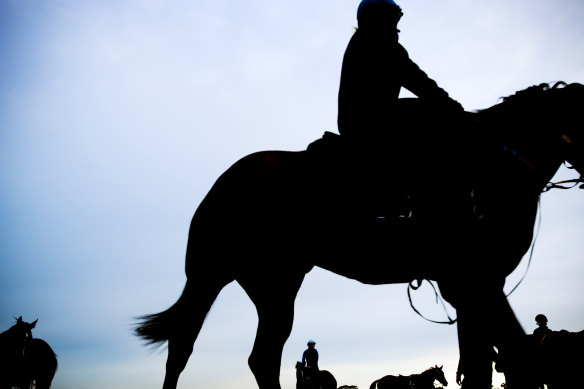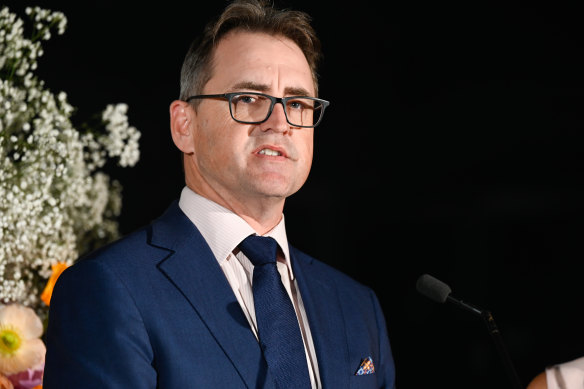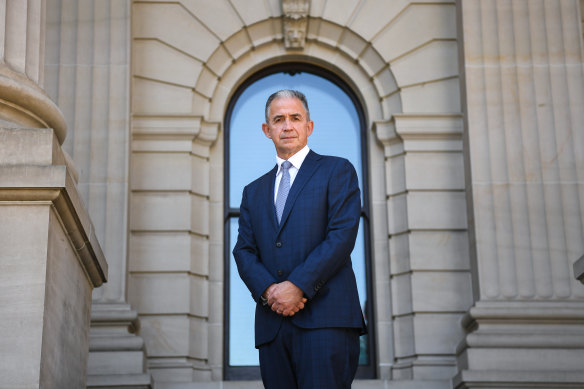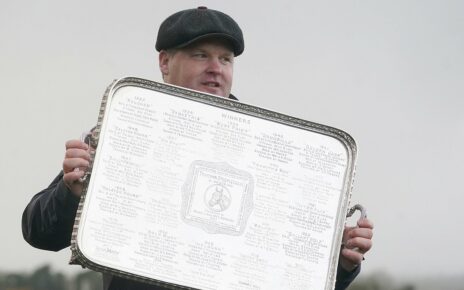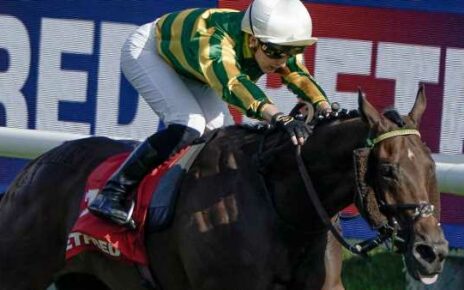Save articles for later
Add articles to your saved list and come back to them any time.
Warning: This story contains graphic content.
Victims of historical sexual and physical abuse in the Victorian racing industry will be eligible for restitution if racing’s three codes adopt a recommendation handed down by the Office of the Racing Integrity Commissioner on Wednesday.
A confronting report has been released into historical physical and sexual abuse in the racing industry in Victoria.Credit: Nick Cubbin
The office, led by commissioner Sean Carroll, handed down a confronting and graphic 78-page report on Wednesday after completing a review of the complaints process for victims of abuse in the racing industry.
Carroll made nine recommendations, which included calls for each of the thoroughbred, greyhound and harness racing codes to establish independent schemes for current and former industry participants who have experienced physical and sexual abuse or harassment.
The schemes, which Carroll said should allow victims to seek restitution and rehabilitation, would need to established within the next 12 months and operate for at least two years.
It comes as Racing Victoria apologised for the harm caused by systemic abuse throughout the racing industry, dating back to the 1970s.
Racing Victoria chief executive Andrew Jones apologised to victims of abuse.Credit: Getty Images
“We acknowledge the harm suffered and, on behalf of the industry, apologise for it,” Racing Victoria chief executive Andrew Jones said in a joint statement with the jockeys’ and trainers’ associations on Wednesday.
“No one should experience physical or sexual abuse, assault or harassment, including in their workplace, and everyone, from employers to colleagues, has a role in ensuring that.
“Racing’s workplaces have changed substantially for the better. The final report recognises that we have taken comprehensive steps to better prevent and respond to harm.
“However, it makes clear that we have more work to do. This includes ensuring those experiencing harm have greater confidence to come forward.”
Dennis Green, a former jockey and track work rider in the 1970s who was subjected to abuse and cruel initiation practises while at Caulfield, participated in the review. He has given this masthead permission to identify him.
Green said he was happy the authorities were being held to account. It wasn’t until the early 2000s that police investigated Green’s allegations, which led to two men being convicted.
“I think it was pretty damning to have my era depicted in pretty graphic terms like that, and I’m grateful for that because any responsible human would be horrified by those accounts and how extensive the harm and criminality and outright depravity was back then, for a lot of kids,” Green said.
“I thought the recommendations were pretty extensive and far-reaching. There’s recognition in there for past victims, so that’s gratifying for me, for sure.”
A number of participants told the review of their distress at knowing some perpetrators still worked in the industry. Identities of the victims referred to in the report were kept confidential.
Over nine months, the office conducted 185 confidential listening sessions. Of the victim survivors who took part in the review, 71 per cent worked in the thoroughbred racing industry, while 31 per cent were harmed before the age of 18, and another 51 per cent were harmed while aged 18-25.
The span of abuse dated from the 1970s to this current decade, and 80 per cent of the victims were subjected to harm in their first three years in the industry.
A culture of silence was the common theme among victim survivors.
One told the review: “Raising awareness [of sexual abuse] just brings your whole career to nothing.
“As soon as you do you are looked upon as a bit weak, they won’t take you around the stables … You have to earn your stripes by not saying [anything]. That’s how you get the good horses.
Racing integrity commissioner Sean Carroll.Credit: Joe Armao
“Well, who is going to believe me? It’s [a high-profile participant]. I’m a kid. Who’s going to believe me?”
Others told the review they hid their shame under a culture of “just getting on with it”.
Brutal initiation rituals during the 1970s and 1980s were commonplace in the thoroughbred racing industry, according to the review.
“Several participants recounted a particularly horrendous initiation where they were tied naked to a lamppost in a busy street, with horse testicles (removed in gelding) wrapped around their necks,” the report said.
Some of the key recommendations
- That senior leaders of racing’s controlling bodies acknowledge the current and historical harm experienced and commit to change in prevention and response to unacceptable behaviour, and educate participants about expected standards.
- Establish a steering committee to implement recommendations, to meet quarterly for at least two years.
- Establish a redress scheme for victims, drawing on best practice from other sports and industries.
- Develop a comprehensive plan to target prevention of physical and sexual abuse, assault and harassment.
- Create and mandate an industry-tailored program on safe and respectful behaviour for all participants.
- Revise and update complaint handling processes.
- Ensure adequate protection and child safeguarding supports.
“All victim survivors who spoke of being the target of initiations – and who knew of others who were
similarly besieged – were minors at the time, no older than 15 years of age, and many were younger.”
The report also detailed sexual assaults on young racing participants, many who lived in dormitories at stables or in share houses with other stable staff.
While 62 per cent of victims who shared their experiences were male, there were also stories of female victims.
One victim survivor told the review: “If you were a girl working in a racing stable, you were classed as an ‘easy’. … If you were working at a racing stable you were ‘asking for it’ … Trainers would walk up beside the girl and touch them … Girls who wanted to go further in the racing industry had to sleep with the boss.”
While the review acknowledged Racing Victoria had done substantial work to build its participant protection policy framework, the review found Greyhound Racing Victoria and Harness Racing Victoria were both without child safeguarding policies.
Victorian racing minister Anthony Carbines described the allegations of abuse and harassment as deeply distressing.
“Their voices have been heard and will drive meaningful and enduring change,” Carbines said. “The commissioner has made nine recommendations to racing control bodies to ensure the industry prioritises the safety and wellbeing of its people and that they are protected by a robust code of conduct.
“I look forward to the Victorian racing industry responding accordingly to intensify its efforts to improve its culture and implement the measures that will deliver the change required.”
Crisis support is available from Lifeline on 13 11 14.
Support is also available from the National Sexual Assault, Domestic Family Violence Counselling Service at 1800RESPECT (1800 737 732).
News, results and expert analysis from the weekend of sport sent every Monday. Sign up for our Sport newsletter.
Most Viewed in Sport
From our partners
Source: Read Full Article

